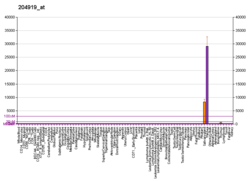PRR4
Proline-rich protein 4 is a protein that in humans is encoded by the PRR4 gene.[3][4]
| PRR4 | |||||||||||||||||||||||||
|---|---|---|---|---|---|---|---|---|---|---|---|---|---|---|---|---|---|---|---|---|---|---|---|---|---|
| Identifiers | |||||||||||||||||||||||||
| Aliases | PRR4, LPRP, PROL4, proline rich 4 (lacrimal), proline rich 4 | ||||||||||||||||||||||||
| External IDs | OMIM: 605359 HomoloGene: 48512 GeneCards: PRR4 | ||||||||||||||||||||||||
| |||||||||||||||||||||||||
| |||||||||||||||||||||||||
| Orthologs | |||||||||||||||||||||||||
| Species | Human | Mouse | |||||||||||||||||||||||
| Entrez |
| ||||||||||||||||||||||||
| Ensembl |
| ||||||||||||||||||||||||
| UniProt |
| ||||||||||||||||||||||||
| RefSeq (mRNA) |
| ||||||||||||||||||||||||
| RefSeq (protein) |
| ||||||||||||||||||||||||
| Location (UCSC) | Chr 12: 10.85 – 10.85 Mb | n/a | |||||||||||||||||||||||
| PubMed search | [2] | n/a | |||||||||||||||||||||||
| Wikidata | |||||||||||||||||||||||||
| |||||||||||||||||||||||||
Lacrimal proline rich protein is a member of the proline-rich protein family which lacks a conserved repetitive domain. It may have a role in protective functions in the eye.[4]
References
- ENSG00000282269, ENSG00000263247 GRCh38: Ensembl release 89: ENSG00000111215, ENSG00000282269, ENSG00000263247 - Ensembl, May 2017
- "Human PubMed Reference:". National Center for Biotechnology Information, U.S. National Library of Medicine.
- Dickinson DP, Thiesse M (Oct 1995). "A major human lacrimal gland mRNA encodes a new proline-rich protein family member". Invest Ophthalmol Vis Sci. 36 (10): 2020–31. PMID 7544782.
- "Entrez Gene: PRR4 proline rich 4 (lacrimal)".
Further reading
- Kimura K, Wakamatsu A, Suzuki Y, et al. (2006). "Diversification of transcriptional modulation: large-scale identification and characterization of putative alternative promoters of human genes". Genome Res. 16 (1): 55–65. doi:10.1101/gr.4039406. PMC 1356129. PMID 16344560.
- Fung KY, Morris C, Sathe S, et al. (2005). "Characterization of the in vivo forms of lacrimal-specific proline-rich proteins in human tear fluid". Proteomics. 4 (12): 3953–9. doi:10.1002/pmic.200300849. PMID 15526346.
- Gerhard DS, Wagner L, Feingold EA, et al. (2004). "The status, quality, and expansion of the NIH full-length cDNA project: the Mammalian Gene Collection (MGC)". Genome Res. 14 (10B): 2121–7. doi:10.1101/gr.2596504. PMC 528928. PMID 15489334.
- Brandenberger R, Wei H, Zhang S, et al. (2005). "Transcriptome characterization elucidates signaling networks that control human ES cell growth and differentiation". Nat. Biotechnol. 22 (6): 707–16. doi:10.1038/nbt971. PMID 15146197.
- Gevaert K, Goethals M, Martens L, et al. (2004). "Exploring proteomes and analyzing protein processing by mass spectrometric identification of sorted N-terminal peptides". Nat. Biotechnol. 21 (5): 566–9. doi:10.1038/nbt810. PMID 12665801.
- Strausberg RL, Feingold EA, Grouse LH, et al. (2003). "Generation and initial analysis of more than 15,000 full-length human and mouse cDNA sequences". Proc. Natl. Acad. Sci. U.S.A. 99 (26): 16899–903. doi:10.1073/pnas.242603899. PMC 139241. PMID 12477932.
This article is issued from Wikipedia. The text is licensed under Creative Commons - Attribution - Sharealike. Additional terms may apply for the media files.


